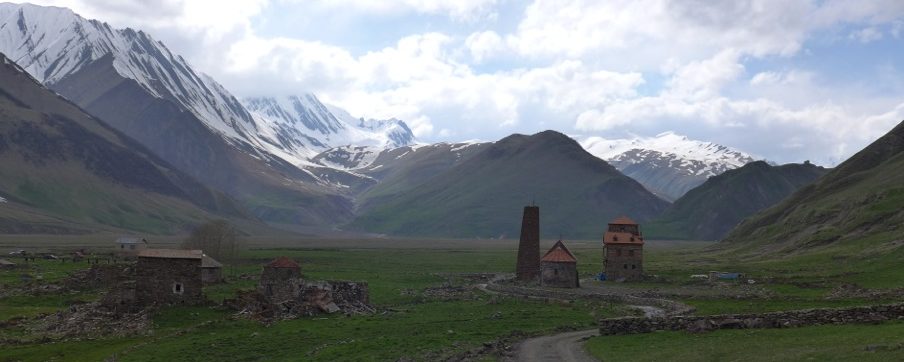One of the best things about Georgia is that you can experience just about every climate and/or terrain within a few hours of Tbilisi.
Craving massive, snow-peaked Caucasus mountains? Great – head north to Kazbegi, or even east to Telavi or Lagodekhi.
Got an itch for some wine tasting in a fertile valley? No problem – head to Kakheti.
Need an escape to some rolling, forested hills? Look no further than Borjomi or Kutaisi.
Or maybe you just want to drink cocktails and lay on the beach – no big deal, Batumi has you covered.
Yet even with all of these options and landscapes at your fingertips, the remote, lunar semi-desert region of Davit Gareja will still manage to take your breath away.

Time Needed
At least 3 hours
Distance from Tbilisi
2-2.5 hours
Reason to Go
Incredible, semi-desert lunar landscapes, breathtaking cave monasteries, fascinating history, and unique frescoes. The lower Lavra Monastery is also one of the few regional cave complexes (out of 15 in the remote area) that is currently inhabited by monks. This makes for an incredible day trip from Tbilisi, or part of an eastern Georgia combination trip (see below).
Transportation
Public marshrutky do not make this trip, so you’ll either have to book a tour/guide, hire/rent a car, or get a taxi for the round-trip from Tbilisi (140 GEL). Cars from Sighnaghi also take about 2 hours, but will cost a bit less.
Regional Combinations
Although Davit Gareja makes for a wonderful day trip from Tbilisi, it can also serve as a great change-up to a multi-day wine-drinking tour of the Alazani Valley, Kakheti, and Sighnaghi. This is also a worthy detour for those heading back to Tbilisi from Lagodekhi National Park after some trekking in the Dagestan Mountains.

Located just two hours southeast of Tbilisi along the Azerbaijan border, the Davit Gareja cave monastery is actually two separate monasteries: Lavra, the beautful (and inhabited) one on the near side of the hill, and Udabno, the stunning, fresco-filled cave complex on the far side.
Davit Gareja also isn’t even a place – it is a person. In the 6th century, 13 “Syrian Fathers” returned from the Middle East to spread Christianity throughout Georgia. Davit Gareja, who founded the Lavra Monastery, was one of them.
Shown above is the Lavra Monastery, just above the parking area.

Many monasteries grew throughout the area. Monks carried out traditional recreational activities, such as winemaking and gardening (thanks to the innovative water irrigation techniques you can see in Udabno), in addition to religious and artistic pursuits, such as translating manuscripts. Most notably, as you’ll see at the Udabno cave complex, a renowned fresco painting school was established here.

You may already be guessing this, but yes, invading armies destroyed Lavra, Udabno, and the rest of the 13 monasteries in this region not once (nor twice), but three separate times. The Mongols destroyed them in 1265, Timur crushed the 14th century repairs, and then Shah Abbas’ soldiers killed (beheaded) 6000 monks on Easter Night in 1615, destroying most of the artistic treasures. Worse, during Soviet times, this area was used for military training, especially tank maneuvers – the monasteries were looted and fell into disrepair as a result.
Georgia has worked to rehabilitate Lavra in particular, among others, in recent years – hopefully this is a regional trend.

From Lavra, you will walk uphill via a clearly marked path next to the Lavra church gift shop. Eventually a railing will appear (and disappear). The view will get better as you go, until eventually you’ll crest the ridge and have a sweeping view of the Azerbaijan plains below.
Above is a view of the path up from Lavra, looking back down.

Once you crest the ridge, the views into Azerbaijan are wonderful. And if you begin to look closely, you can see pockets of darkness just above the trail as it continues down on the far side of the ridge – these are the caves you’ll soon be visiting.

The first third or so of the caves are bare bones – limited to no frescoes and lots of damage/erosion.

About halfway down the path, though, the rooms light up with color, even if faded. Most of these frescoes date from the 10th to 13th century.

Luckily, the caves are now numbered (discreetly), which allows to follow along the history and significance of each cave. Books like Lonely Planet can walk you through the caves, as can the pamphlets provided as you walk in.

About fifty meters past cave #50 is a path that leads up, over, and back towards #36, the Refectory. One of the more notable frescoes in the complex is located here – The Last Supper from the 11th century.

Monks would kneel to eat at these low tables in the Refectory.

And the refectory viewed from the trail. The caves are literally dug, and built, directly within the cliff itself. You can find similar arrangements all over the world, such as Capadocia (Turkey), Dogon country (Mali), and even Colorado (link).

Although at first you may find it odd that these monks wandered in a semi-desert for days, only to settle in barren, stone caves, once you realize that they spent their time productively through religious scholarship, academia, or even the arts, all with wine and recreation (and with this incredible view), it doesn’t seem that bad at all. It actually seems like a great life.

In cave #42, the black and blue colors are particularly striking.

Eventually the path will climb back up and over the ridge – you’ll have a great view from here (above). Just past a stone chapel, you’ll head back down towards Lavra.

Descending back down to the Lavra monastery.

Every different perspective can leave you with an equal amount of awe.

If the weather has shifted (and it likely will), your view from the watchtower will be different than when you arrived.
